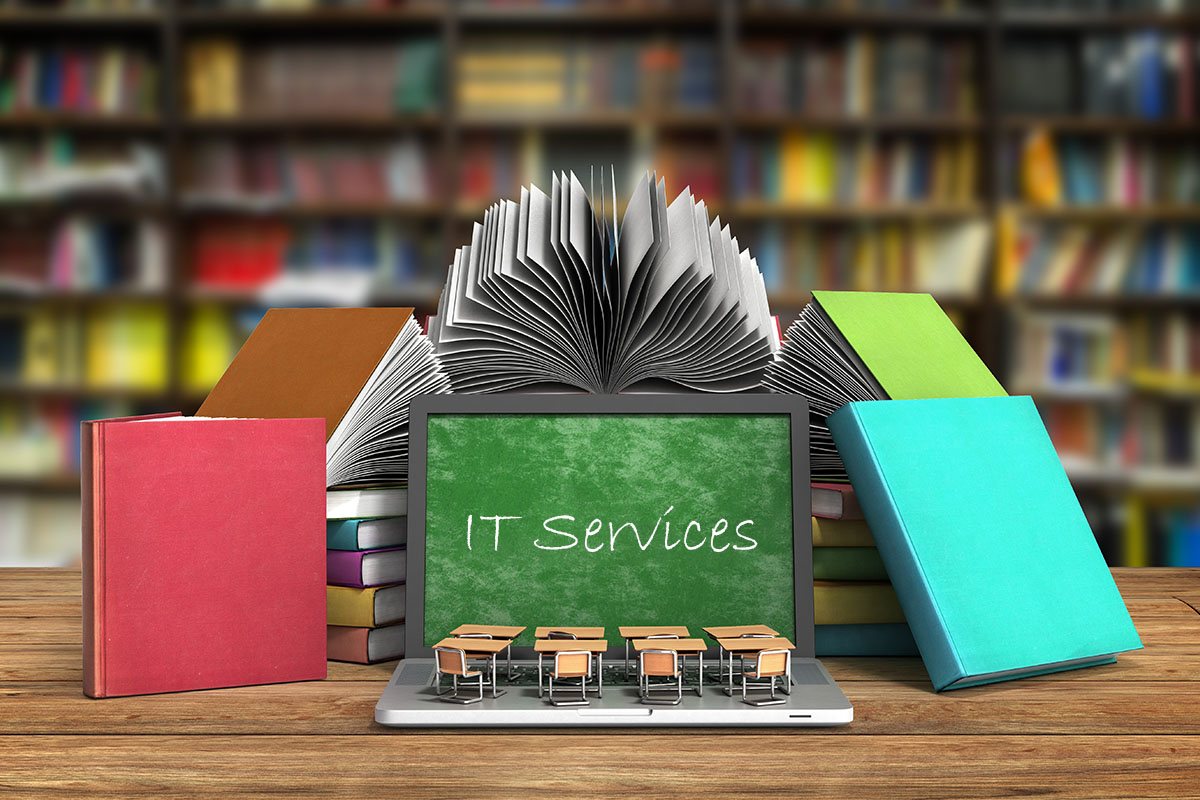

Seattle Managed IT for Schools & Universities: Best Practices Guide



Having a strong IT infrastructure for schools enables effective learning and teaching, supports educational technology, and fosters a connected community. A Seattle managed IT provider can help K-12 schools and other institutions keep up with the rapid development of technology and prioritize their systems in order to address modern challenges.
We’ll focus on key areas critical for improving educational environments:
- Network Optimization: Reliable connectivity and bandwidth for all users.
- Cybersecurity Measures: Protecting sensitive data from increasing cyber threats.
- Modern Solutions: Leveraging IT consulting in Seattle WA to evaluate and implement innovative technologies that streamline operations while supporting diverse learning models.
Understanding IT Infrastructure Needs in Education
Educational institutions increasingly rely on robust IT infrastructure to support their missions. K-12 schools face unique challenges that can hinder their ability to provide effective educational experiences.
Challenges in K-12 IT Infrastructure
K-12 schools encounter several common challenges when it comes to their IT infrastructure:
1. Outdated Technology
Many schools operate on legacy systems that are no longer efficient or secure. This outdated technology often lacks the necessary features to support modern teaching methods and learning tools. As a result, students may not have access to the resources they need for a comprehensive education.
2. Budget Constraints
Limited budgets impacts technology upgrades within educational settings, leaving little room for investing in new hardware or software. This often leads to a reliance on outdated systems, which can become increasingly expensive to maintain as they age.
3. Cybersecurity Threats
With the rise of digital learning environments, cybersecurity has become a top priority for K-12 IT leaders. Schools frequently face threats such as data breaches, ransomware attacks, and phishing scams. The sensitive nature of student and staff information makes these threats even more concerning. An inadequate security framework can expose institutions to serious risks, including legal liabilities and reputational damage.
Strategies for Addressing K-12 IT Infrastructure Challenges
Here are some strategies that can help address the challenges faced by K-12 schools:
- Conduct regular audits of existing systems to identify weaknesses.
- Develop a strategic roadmap that aligns with long-term goals.
- Prioritize cybersecurity measures, such as implementing firewalls and intrusion detection systems.
Collaboration among school districts can enhance resource sharing and strengthen cybersecurity efforts. By pooling resources, schools can invest in more advanced technologies and security measures, ultimately improving their overall IT infrastructure.
Modernizing Legacy Systems
Assessing current infrastructure is integral for understanding IT needs for schools. Legacy systems presents risks, including:
- Security vulnerabilities: Outdated technology often lacks critical updates, exposing schools to cybersecurity threats.
- Performance issues: Slow systems can hinder learning and administrative processes.
- Increased costs: Maintaining older systems can lead to higher repair and support expenses.
Modernizing infrastructure offers several benefits:
- Improved performance: Upgraded systems enhance speed and reliability, promoting a better educational experience.
- Enhanced security: Modern technologies include robust security features that protect sensitive data and comply with regulations.
- Tailored solutions: Customizing upgrades to meet specific educational requirements so technology aligns with teaching goals.
To effectively upgrade outdated systems, consider these steps:
- Evaluate existing systems: Identify gaps in performance, security, and functionality.
- Prioritize upgrades: Focus on the most critical areas first based on budget constraints in schools.
- Develop a modernization plan: Create a phased approach to implement changes gradually while minimizing disruption.
Future-Proofing Educational Technology
Establishing a future-proof IT infrastructure should be a top priority for educational institutions. The following strategies can help the long-term viability of your IT investments:
1. Strategic Planning
Assess current and future needs. Develop a roadmap that aligns with institutional goals. Regularly review and adjust strategies based on technological advancements and educational requirements.
2. Incorporate Scalable Solutions
Choose technologies that can easily adapt to growth, such as:
- Cloud solutions
- Virtualization technologies
- Modular hardware systems
Prioritize flexibility in your infrastructure to accommodate fluctuations in student enrollment or program offerings.
Cloud Solutions in Education
Cloud computing has emerged as a transformative force within educational settings. The advantages of adopting cloud technology include:
1. Cost Efficiency
- Reduced need for extensive on-premises hardware.
- Pay-as-you-go pricing models help manage budgets effectively.
2. Accessibility and Collaboration
- Enables learning from anywhere, fostering collaboration among students and educators.
- Facilitates resource sharing across institutions, maximizing the use of available technology.
3. Enhanced Security Measures
- Many cloud providers offer robust security protocols.
- Regular updates and monitoring help mitigate risks associated with data breaches.
Hybrid Cloud Strategy
Combines the benefits of both environments, enabling seamless integration. Supports critical applications while leveraging the scalability of cloud resources. Considerations for implementing a hybrid model include:
- Data Management: Determine what data remains on-premises versus what is migrated to the cloud.
- Compliance Requirements: Stay compliant with regulations such as FERPA when handling sensitive student information.
Network Security Considerations
Educational institutions face unique challenges when it comes to network security. A thorough strategy is vital to protect sensitive data and maintain working integrity.
Layered Defense Strategy
A layered defense strategy safeguards the networks of schools and universities. This approach involves multiple security measures that work together to create a comprehensive barrier against threats. Key components include:
- Firewalls: Act as the first line of defense, filtering incoming and outgoing traffic.
- Intrusion Detection Systems (IDS): Monitor network activities for suspicious behavior.
- Antivirus Solutions: Protect systems from malware and other malicious software.
Zero-Trust Architecture
Transitioning to a zero-trust architecture can enhance network security for universities. This model operates on the principle of “never trust, always verify,” meaning that every user and device must be authenticated before access is granted. Features include:
- Continuous monitoring of all network traffic.
- Strong authentication processes, such as multi-factor authentication.
- Strict access controls based on user roles.
Data Encryption and Access Control
The importance of data encryption cannot be overstated in educational environments. Encrypting sensitive information guarantees that even if data is intercepted, it remains unreadable without the correct decryption keys. Implementing strict access controls helps limit who can view or manipulate this data. Effective strategies include:
- Assigning permissions based on user roles.
- Regularly reviewing access logs for unusual activities.
- Implementing role-based access controls (RBAC) to minimize unnecessary exposure.
By prioritizing these elements, schools and universities can create a fortified environment that supports effective learning while protecting critical assets from cyber threats.
Enhancing Learning Experiences with Technology
Technology influences personalized learning experiences in educational settings. By integrating digital learning tools, educators can tailor curriculum and instruction to meet the unique needs of each student. This customization enhances engagement, motivation, and academic performance.
The Role of AI in Education
Artificial Intelligence (AI) analytics play a transformative role in supporting educators and improving student outcomes. Through data-driven insights, AI helps identify individual learning patterns and areas where students struggle. Benefits include:
- Personalized Feedback: AI systems can provide real-time feedback to students, allowing them to understand their progress and areas for improvement.
- Resource Allocation: Educators can utilize AI analytics to allocate resources effectively, so struggling students receive the necessary support.
- Predictive Analysis: By analyzing historical data, AI can forecast student performance trends, enabling early intervention strategies.
Professional Development for Educators
To maximize the potential of digital tools and AI analytics, ongoing training for educators is essential. Professional development on technology and cybersecurity is vital for several reasons:
- Embracing Change: As educational technologies change, teachers must stay updated on the latest tools and methodologies to effectively incorporate them into their teaching practices.
- Cybersecurity Awareness: Educators must understand cybersecurity risks associated with technology usage. Training programs should cover best practices for protecting sensitive information and maintaining compliance with regulations such as FERPA.
- Collaborative Learning: Ongoing professional development fosters a culture of collaboration among educators. Sharing experiences and strategies encourages innovation and effective tech adoption across departments.
Strong IT Infrastructure with Proactive Management
IT infrastructure is the backbone of education. Institutions must prioritize continuous assessment and adaptation to meet evolving educational demands. Regular evaluations will identify gaps and highlight opportunities for improvement. This proactive management approach allows schools and universities to effectively integrate new technologies, enhance security measures, and support diverse learning environments.
Key strategies include:
- Establishing a Strategic Roadmap: Create a phased plan outlining goals, milestones, and timelines.
- Implementing Regular Audits: Conduct assessments to review system performance and user needs.
- Investing in Training: Empower staff with ongoing professional development to maximize technology use.
Starting your journey towards a future-proofed school or university today will help secure the necessary resources and support for sustainable growth. A robust IT infrastructure enables institutions to thrive, enhancing learning experiences while safeguarding sensitive information.
Frequently Asked Questions About IT Management
What is the importance of IT infrastructure in educational settings?
Robust IT infrastructure is critical in educational settings as it supports digital learning, enhances communication, and facilitates efficient management of resources. It empowers schools and universities to implement advanced educational technologies, so students and educators have access to the tools they need for effective teaching and learning.
What are the common challenges faced by K-12 schools regarding IT infrastructure?
K-12 schools often face challenges such as outdated technology, budget constraints that limit upgrades, and increasing cybersecurity threats. These issues can hinder the implementation of modern educational solutions and affect overall learning outcomes.
How can schools assess their current IT infrastructure needs?
Schools can assess their current IT infrastructure needs by evaluating existing systems for effectiveness, identifying gaps in technology, and understanding specific requirements based on educational goals. This assessment should also consider budget constraints and potential cybersecurity risks.
What are the benefits of modernizing legacy systems in education?
Modernizing legacy systems offers numerous benefits including improved performance, enhanced security against cyber threats, and greater compatibility with new technologies.
What strategies can be employed to future-proof educational technology investments?
To future-proof educational technology investments, institutions should focus on scalable technology solutions that can grow with their needs. Incorporating cloud computing can also provide flexibility and accessibility by leveraging outsourced IT in Seattle.
Why is network security important for universities, and what measures should be taken?
Network security protects sensitive data from cyber threats. Implementing a layered defense strategy, utilizing advanced security tools, adopting zero-trust architectures, and enforcing strict data encryption and access controls are measures to safeguard networks in educational environments.
Table of Contents

